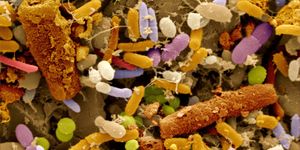One of the key areas in all of biology is the evolution of photosynthesis. Some species of single celled cyanobacteria, through photosynthesis, forever changed the atmosphere of the early Earth by filling it with oxygen, allowing a huge expansion in terms of what life was possible on the planet.
Cardona et al, in the advanced online edition of Molecular Biology and Evolution, have examined the evolution origins of the D1 protein in cyanobacteria, which forms the heart of Photosystem II, the oxygen-evolving machine of photosynthesis. Photosystem II's role is to procure electrons for photosynthesis and it does this by ripping them out of water releasing oxygen as a byproduct. The research team selected all known D1 sequences from cyanobacteria and also representatives from algae and plants to compare the protein sequence variation.

"I think the most significant implication of the paper is that now the evolution of biological water oxidation can be addressed experimentally," says Tanai Cardona, PhD. "It is quite possible that in extant cyanobacteria today Photosystem II, using these ancestral forms of D1, could display traits and perform chemistry that resemble those of transitional forms before the evolution of efficient water splitting as we understand it today. The study of this alternative photosystems will not only give insights into the evolution of the process but could also provide clues on the environmental conditions where oxygenic photosynthesis first arose billions of years ago in the early Earth."
The researchers showed that D1 exists in at least 5 major forms, some of which could have originated before the evolution of water oxidation. This allowed the team to make a detailed evolutionary tree and to propose a sequence of events for the origin of water splitting in Photosystem II at an unprecedented level of detail. The earliest diverging form of D1 has maintained ancestral characteristics and was found in the recently sequenced genome of Gloeobacter kilaueensis JS-1 (found in a lava cave in Hawaii), probably one of the most primitive type of cyanobacteria known
A remarkable evolutionary innovation occurred around 3.2 to 2.7 billion years ago in a bacterial ancestor of cyanobacteria, made possible by key transitionary forms of D1. Their evidence suggests that water splitting could have evolved relatively fast after just a few changes to the ancestral D1 protein of Photosystem II. This ancestor contained several forms of D1 and may have been a lot more complex than previously thought, already highly specialized for the solar-powered oxidation of water.
The article is titled "Origin and Evolution of Water Oxidation before the Last Common Ancestor of the Cyanobacteria."
[Source: Molecular Biology and Evolution (Oxford University Press)]









